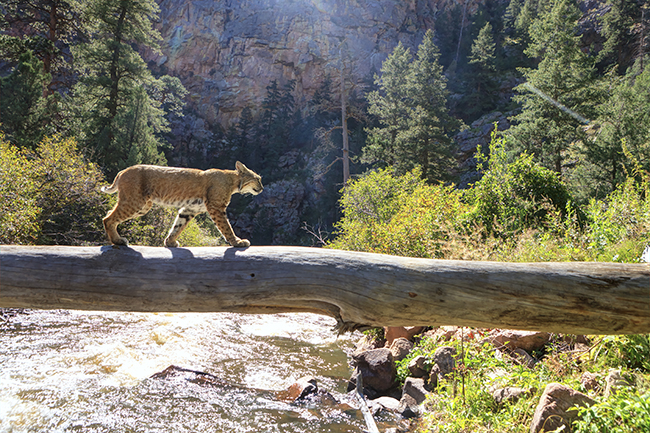Wild Child
03 Oct 2024
Letting kids bloom in the outdoors
By Mara Welty
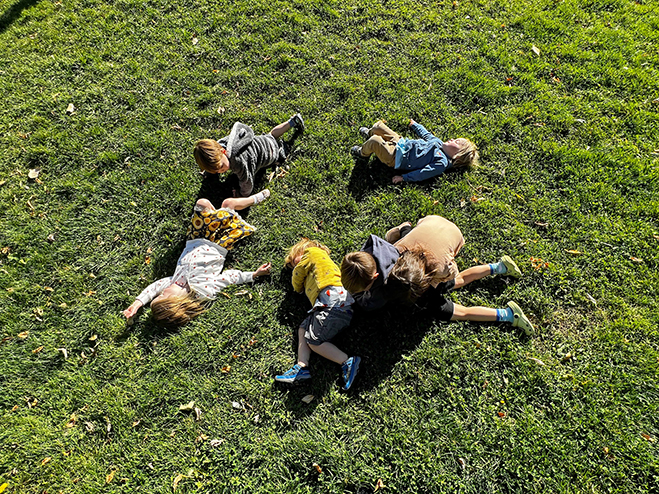
If you’re looking for a place to play in Colorado, Boulder delivers on all fronts—it’s a vibrant, interactive canvas where kids can hike through breathtaking trails, splash in pristine streams and discover natural flora in the hills of Chautauqua—and immersion in the outdoors is more crucial than ever.
In an era where screens reign supreme, urban sprawl encroaches and green spaces dwindle, more and more children are spending their days sedentary and inside, as noted by the American Academy of Pediatrics—and the effects aren’t just physical. This shift is linked to rising rates of anxiety, depression and other health issues in children like behavioral problems, attention difficulties and a diminishing of the senses, which some researchers are referring to as Nature-Deficit Disorder.
This disconnect may also affect their relationship with the environment. Studies indicate that reduced outdoor exposure weakens both our understanding of and our sense of responsibility for the natural world.
Fortunately, Boulder organizations are taking a stand—and offering a helping hand to families looking to prioritize time in nature.
Generation Wild, a subsidiary of Great Outdoors Colorado (GOCO), is leading the charge by providing outdoor programs, innovative activities, community events and resources to help rekindle children’s love for the outdoors and bridge the gap created by our increasingly digital world. Fittingly, one of its taglines declares, “Kids Grow Better Outside.”
“It makes them healthier and happier,” says Jackie Miller, the executive director at GOCO.
“Growing up, I never really played beyond my backyard,” Miller says. “This is not to devalue the importance of playing in your own backyard, but I was inspired by some of my parents’ friends, who took me out on hikes for the first time. It was a turning point in my life, feeling like I was a part of something bigger than myself.”
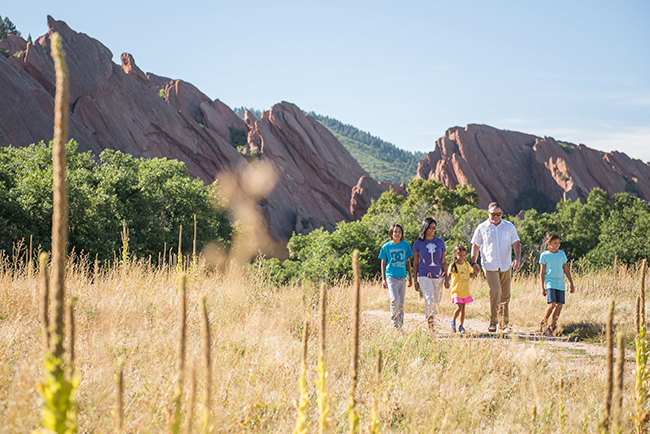
“When GOCO asked ourselves what we could do to address the growing disconnect between youth and the outdoors, I identified with the kids who might not have as many opportunities to get out there,” she continues. “Raising two girls of my own, I also know how hard it is for parents these days to create time to get outside with intention, and I wanted to be part of a solution that made the outdoors more accessible for everyone.”
GOCO’s 12 Generation Wild coalitions across the state serve as resources and gathering places for local communities, helping to break down community-identified barriers to outdoor access. The Boulder County branch, Nature Kids/Jóvenes de la Naturaleza, hosted by Thorne Nature Experience, has two goals: To guarantee that every young person in Lafayette lives within a secure 10-minute walk to natural spaces and to engage youth with nature through a range of programs.
“Kids can have an opportunity to connect to an outdoor experience that speaks to them, whether that’s biking or fishing or camping or picnic games,” says Miller. “The coalitions are also offering pathway opportunities to some older kids in those communities, providing opportunities for internships and jobs in the outdoors.”
So far, GOCO has reached over 270,000 youth participants in Colorado.
And they aren’t alone.
Growing Up Boulder (GUB) is an expansive nonprofit initiative that aims to empower children and youth by making Boulder a more inclusive, child-friendly city—specifically through child-led projects.
One of its initiatives, Nature Connection, focuses on fostering a deep bond between children and the natural world. Through this program, Growing Up Boulder creates opportunities for youth to engage in outdoor exploration, advocate for accessible green spaces and take part in hands-on environmental projects.
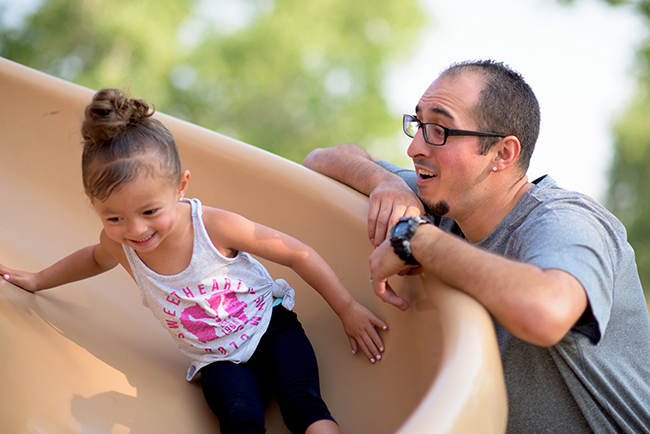
One such project focused on building an inclusive playspace using Universal Access Design (UAD), a design approach that ensures the area is accessible, easy to navigate and enjoyable for everyone—regardless of age, size, ability or disability. The goal was to create a space where all kids can play, explore and connect with nature without barriers.
The group of second-grade English Language Learner (ELL) students at Whittier Elementary School traveled to three different playgrounds and spoke to local experts of varying needs and abilities. Following their research, they shared their recommendations for creating inclusive playspaces, which were communicated to staff at the City of Boulder Parks and Recreation working on accessible playground design.
“It was amazing,” says Mara Mintzer, Executive Director and Co-Founder of GUB. “One of the things that’s so important to me is that we want to make our city more equitable and sustainable for all, and we do it in a few different ways, one of which is directly hearing from kids, and finding out what they want to make those spaces better for them. What I find fascinating is that the kids think about inclusivity, even if we haven’t raised it ourselves. From the elementary school-age kids, one of the top things that they requested was more accessible outdoor spaces for themselves and their peers.”
And bugs, too.
In 2023, Growing Up Boulder teamed up with the City of Boulder to reimagine and revitalize Primos Park, a nine-acre site on Violet Avenue between Broadway and 19th Streets. The project was guided by input from local families and community members who, until then, often overlooked the park, unaware it was a public space open for community use.
“When Growing Up Boulder invited us to explore Primos Park and share our observations with them, we were excited,” say educators at Boulder Journey School. “We believe children have a right to actively participate in their community, including caring for others and caring for our surroundings. We noticed as soon as we crossed the threshold of the park, the children became immediately engaged with their surroundings. The feel of the breeze, the rustle of the leaves, the crunching of the snow and the vast openness made the rest of the world fade away.”
And the children agree, “Everything makes me feel happy at a park. One time, we were rolling down a hill and we were laughing and laughing and laughing,” said Louisa, age four.
Since the park’s revitalization, accessible stairways have been added, neighborhood picnics hosted, butterfly nets shared and creative bug communities constructed.
“Some of the kids were suggesting that there should be a bug playground or bug hotel, and asking themselves, ‘How do we make sure we’re caring for the bugs because they’re so little, and how can we make sure they can reach the zip line?’” says Mintzer. “They wanted to make sure it was accessible—even to the bugs.”
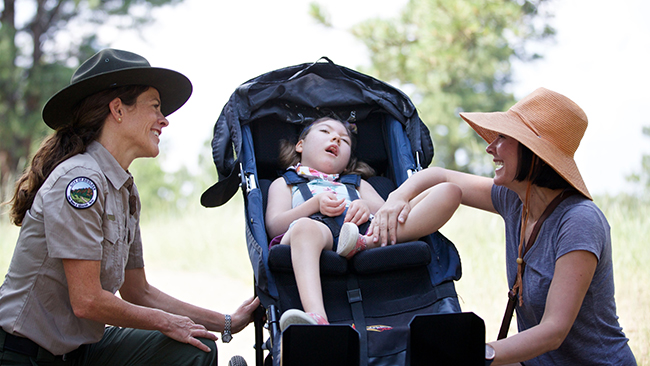
Accessibility is critical—research shows that exposure to nature and green spaces can have an especially positive impact on children in disadvantaged populations.
Mark Davison, Senior Planning Manager at Boulder Parks and Recreation, who worked with GUB on the Primos Park project, has experienced this first hand.
In 2013, Davison and his wife Danae received the news that their three-year-old daughter Lydia had five brain malformations, which doctors feared would prevent her from living beyond the age of seven. Now 11, Lydia loves the outdoors and inspires Davison to conceptualize accessible spaces throughout Boulder that follow UAD.
“Much of the great work I believed I was doing in my job seemed to only create additional barriers for my daughter to access nature, from added steps on trails to inaccessible environmental education programs,” Davison writes. He also points out that the standards set by the Americans with Disabilities Act (ADA) for play structures, although well-meaning, frequently fall short. Playground mulch can often impede wheelchair access, and park facilities rarely have the accommodations needed for parents to care for tweens, teens and young adults who experience disabilities.
Thus, Davison propositions a pivot—to the senses.
To make UAD truly accessible to everyone, designs must also incorporate numerous sensory experiences. Further, Davison hopes to prioritize experience and skill-building over safety and comfortability, creating opportunities for children of all abilities to grow and learn through hands-on challenges in the outdoors. It’s what he calls “the dignity of risk.”
“Children with disabilities and their families should have the opportunity and support needed to engage in risky play and outdoor activities to whatever extent they desire—whether in a universally-designed greenspace or on an overnight camping trip,” he attests.
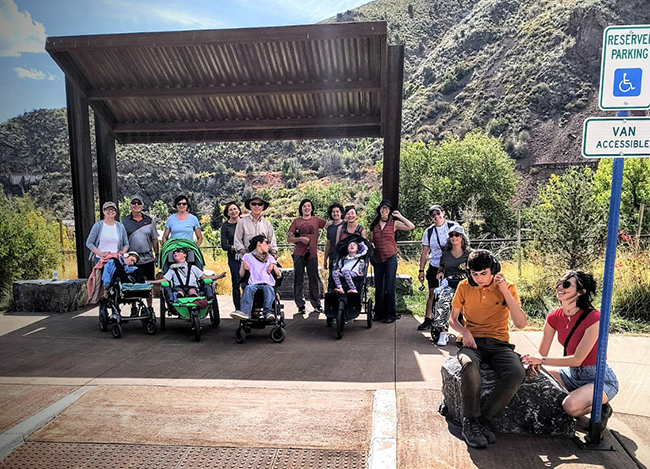
Lydia, who experiences the world without the majority of her sight or the use of her legs, delights in the sounds and sensations of nature. Davison organizes monthly Roll-n-Stroll events to prioritize her outdoor time. These gatherings bring together families with children who experience disabilities, offering them the chance to explore accessible trails, exchange advice, build connections and provide a sense of normality and independence for their children.
With more than 100,000 acres of open space, Boulder County offers abundant opportunities for children of all ages and abilities to explore the outdoors. To understand more about the initiatives supporting outdoor play, visit generationwild.com, growingupboulder.org and bouldercolorado.gov.

